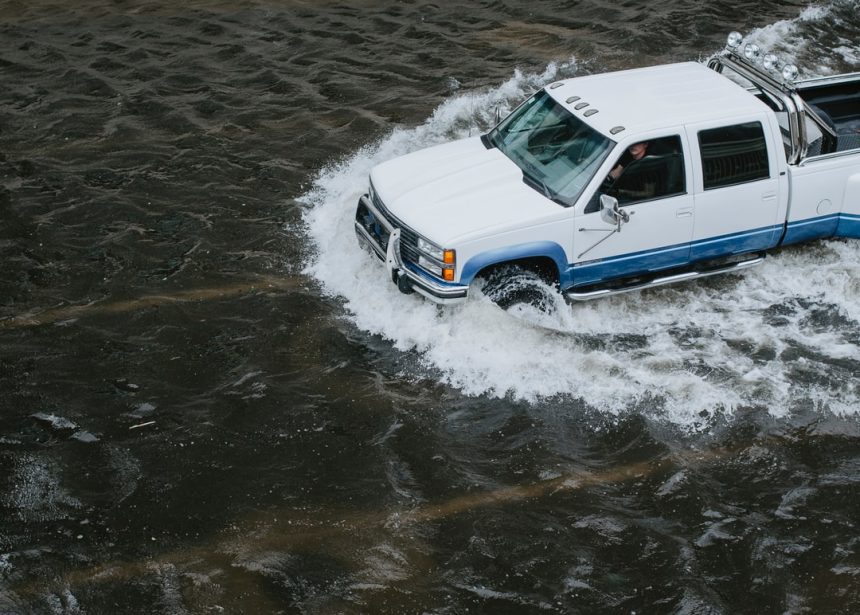The National Weather Service slogan, “Turn Around Don’t Drown,” is something that you should not ignore. Driving through flood waters not only can result in car damages, but it can also run the risk of leaving you stranded. More than 60% of flood related deaths happen in vehicles because of misjudgment of how deep the water really is.
When you see flood water on the road, there are a few tips that you will need to keep in mind so that you return home safely. If you are looking for essential tips on how to navigate through flood waters and why it is unsafe to do so, you will want to keep reading below. In this brief article, we will go over the dangers of flood water and how you can keep yourself safe if you find yourself needing to drive on a flooded street.
Dangers of Flood Water
Driving through flooded streets is an extremely dangerous thing to do. Not only are you not able to properly gauge the depth of the water on the road through your windshield, but you also can cause some severe damage to your car. You can cause damage to your brakes, engine, and the electrical parts of your vehicle.
Brake Flood Damages
Water usually does not affect your brakes when driving through typical rainy weather, but flood water is a whole different story. When driving, your brakes tend to become hot.
When you suddenly drive through a cold puddle, the sudden drop in temperature can cause your disc brakes to bend. It also can cause your brake pads to crack, which can leader to premature wear and tear.
Engine Flood Damages
Driving through water that is higher than your bumper can cause water to seep into your engine. It is vital that if you do go through flood water, that you pay attention to your engine.
If you hear any strange noises or feel any jolting, you may have engine damage. Water in the combustion chamber can lead to something called “hydro lock.” You will want to inspect your vehicle as soon as you are safe to do so. If you hear any loud noises, you may have a problem with your alternator.
Electrical Flood Damages
Technological advancements have impacted the way we work, but it also affects the way we drive. A lot of cars today have a lot more sensors and electronic parts. These components are usually designed to be water-resistant, but it is always best to check them out.
If you notice that your sensors, electric windows, or radio are not working, you may have an issue with your electrical systems. If you decide to check out these systems, make sure that you do not do them independently. You can risk an electric shock if you aren’t too careful.
Car Interior Damages
When you are in a safe area, it is best to inspect the inside of your vehicle. Even if a little bit of water got into the interior of your car, you might want to have it checked. Leaving water inside of your vehicle can cause the carpets to develop mold.
Can I Claim Water Damage?
If you drove through water on the road and now you have damage to your vehicle, you have the opportunity to claim those damages through your auto policy. Under your auto insurance policy, you may have elected for a coverage called comprehensive coverage. If you don’t already have this insurance coverage, you may want to reach out to a reputable insurer like Lloyds of London flood insurance.
What Is Comprehensive Coverage?
Most people confuse their comprehensive coverage with their collision coverage. Yes, they both carry a deductible, but they are in place for two different reasons.
Your collision coverage helps when you are in an accident with another vehicle or object. Comprehensive coverage helps you in the event that your vehicle receives damage from driving through flood waters.
Driving Safety Tips
If you find yourself having to drive through flood waters, there are a few things you will want to do. If you can, try to pull over as soon as possible if you are driving through flood waters while it is raining.
Drive Down the Center
If you must drive through a flooded street, you should drive down the center between the two lanes. Water is more shallow at the center of the road.
Take Turns With Other Vehicles
It is best to try to create a single line behind other drivers in your same lane. By driving in a single line, you reduce splashing water onto other drivers.
Driving under wet conditions is already a stressful situation; there is no need to add extra frustration. Plus, driving behind the vehicle in front of you provides you with better traction because they are moving water out of your way.
Drive Slowly
The last thing you want to do is lose control of your vehicle because you were speeding. Not only can you hydroplane, but you could also cause severe damage to your engine.
It is best to drive between one to two miles per hour. If you need to speed up, try not to go any faster than five mph.
Turn Around Don’t Drown
If you are ever caught in a situation where you have to drive through flood waters, you must drive as carefully as you can.
Ensure that you check the weather channel before heading out for the day to ensure that the roads are clear enough for you to travel through. If you enjoyed this article and want to learn more about flood water safety, check out our Property section today for more information!















